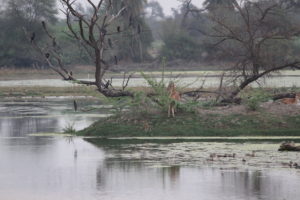My first ever tiger sighting in Ranthambore National Park! If only my DSLR could capture the thrill and adrenaline rush which I experienced when this mighty tigress crossed me in the middle of forest in Ranthambore National Park.
I could not find a detailed blog which could answer all my queries. So I decided that I will pen down the smallest of things while traveling.

Ranthambhore National Park is located in the Sawai Madhopur district of eastern Rajasthan. The Park today attracts a lot of tourists and wildlife photographers from across the globe. Apart from rich flora and fauna, Ranthambore is also counted among the famous heritage sites of India, courtesy the 10th-century Ranthambore Fort and striking ruins that dot the dry deciduous forest.

Did you know that the most photographed tigress in the world – Machali, was a resident of Ranthambhore National Park? The royal tigress passed away at the age of 20, making her the world’s oldest-surviving tigress in the wild. Many consider Machli to have been the most photographed tiger on Earth, and her image appeared in innumerable magazines, newspapers, blogs, calendars, and more.
The Ranthambore forest is spread across an area of 1,334 sq km. According to the officials, it is home to 70 tigers, Leopard, Caracal, Fishing Cat, Jungle cat, Sloth bear, Striped hyena, Jackal, Nilgai, Indian Gazelle and huge variety of deer including Chital and Sambar. Due to its proximity to the Thar, the region receives very scanty rainfalls and so the vegetation in the park mainly comprises of the dry deciduous type. The most noticeable tree in the Ranthambore National Park is the ‘Dhok’ (Anogeissus pendula). It is dominant species and constitutes about 80% of the vegetation cover and found on hill slopes and valleys and maintains luxuriant growth due to better soil formation and water holding capacity. The leaves of the Dhok trees form a favorite diet for the Deer, Nilgai and Antelope.

Most important question- How to decide the Zone?
Tigers are territorial animals and they have marked their territories in the national park. So, there are 10 zones out of which 1-5 are the zones in the core area and 6-10 are buffer zones. It is said that sightings are more common in core area because of the water bodies like Padam Talao etc. However I will tell you that there is an equal probability of sighting in the buffer zone as explained in our next blog: “Best Zone For Tiger Sighting in Ranthambore National Park”.

Where to book the safari?
There are multiple options to book a safari. You can either book through a government website, an agent or through your hotel. We booked two morning safaris- one through Hitch-Hike (a gypsy and zone 3) and the other through our hotel ( a canter and zone 10). I will explain the details and you can figure out the difference as you read through the blog.
How to Reach the park?
The nearest airport is Jaipur International and railway station is Sawai Madhopur. You can take a cab from airport or station as per your convenience. Alternatively, you can reach Delhi by flight or train and then hire a cab to reach your hotel directly. We stay in Gurgaon so we travelled around 365 kms to reach the park. It was fun!
Where to stay?
There is no problem in finding an accommodation as you will get multiple options of budget( 800 INR), middle range( 3000 INR) and luxury( 70,000 INR) to stay. We stayed in Ananta Bagh Elite (4500 INR) and our experience was wonderful. Hospitality at its best!


Morning Vs Evening safari?
In my opinion, Morning safari(6 am-9 am) is better as the chances of spotting are more. We talked to many people during our stay from both the safaris and the experience was different for both the groups but the sightings were more in morning safari than evening. Honestly it is sheer luck and bad days are simply those when the tiger/tigress refuses to show up.

Where to eat?
My suggestion is to book an all inclusive deal with your hotel as you will have to drive to Sawai Madhopur for restuarants and there are very few to name. Alternatively, you can experience luxury dining in Oberio by advance booking.

Difference between a Canter and a Gypsy?
I have experienced both. Canter is like a big bus which can accommodate 20 people on the top while a Gypsy is similar to a Jeep which can accommodate 6 people. I found Gypsy more comfortable but we had to spend a little more and it was worth spending. You get the option of both while booking.

What are the things which can you do apart from safari?
Safari is the highlight of Ranthambore even if there is no spotting. However, there are a few activities which you can include in your itinerary if you have time:
- View Sunset at Palighat Gharial Sanctuary:

You need not hire a boat to see the crocodiles/Ghariyals or do camping here as it is expensive. You can rather drive to this place and enjoy the beautiful sunset as we did.

- View the park from the Ranthambore Fort:

You can see this mighty fort when you go in the core area as well but if you need to see the zones from the top then climb up this fort and witness the beautiful sunrise. You can drive and park your car on the entrance and then climb up the stairs to reach the top.
- Visit Sawai Madhopur:
It is a Rajasthani city where all your basic needs can be fulfilled. You can try some dhabas or local restaurants to eat, buy some souvenirs for your loved ones from Dhonk and Village Women Craft and learn about the culture from the local people.
My first ever experience of tiger sighting:
It was 6 am, that we started our Zone 3 safari in Ranthambore National park. Zone 3 comes in the core area along with Zone 1-5 and there is a high chance of spotting tiger in these as we learned.

Soon as we entered we spotted a lot of Peacocks, Chital , Nilgai and Sambar but our guide insisted us to search for a tigress and then we could enjoy the flora and fauna of the national park which we agreed.

Believe me when I say it is absolutely thrilling to chase a tigress by looking for its fresh marks and listening to your guide when he talks to his fellow gypsy and canter drivers for the last spotting, fresh kills and alarms of the animals in jungle.
We were going almost crazy when we saw a group of gypsy and canter waiting and we rushed to the spot knowing that they have seen a tigress moving towards a herd of deer in the bushes.

I thought that the animals run away but a herd of deer was standing still and our driver was telling us to be camera ready as this was a time when the tigress can emerge from any bush. We waited for around 15 minutes in silence while adjusting our frames from left to right because the grand entry could not be missed. The forest was extremely silent when the beautiful tigress emerged from behind the bushes and started walking towards us.

What a view!! A mighty tigress walking down the aisle and the humans moving their gypsy to give space to her. Apparently, she had filled her stomach and was heading towards the other side for water and a good nap(Our guide told us).

Unwilling to pay us any attention, she continued walking to our right. To my surprise, She was very comfortable with the humans around and people were busy clicking pictures making sure that there is extreme silence (no flash and camera clicks).

We spotted our first tigress in any national park. Our driver was equally excited and kept repeating that now your bad-luck spell is broken and you will see tiger in all your safaris😊. I mean, “ How wonderful! My first sighting was beyond imagination”.
We then followed the tigress to her usual spot where we found her drinking water and taking a nap but we could not take a picture as the frame was not clear. But no regrets as our earlier pictures were perfect. We returned to our hotel, took a quick shower and went straight to the pool still discussing the thrilling moments which we experienced an hour before!

We booked another safari in Zone 10 for the next morning which you can read in our next blog: “Best Zone For Tiger Sighting in Ranthambore National Park”.
I have written everything about Ranthambore in one place and if you have any questions you can contact us on the number mentioned on our website. We hope you spot the big cat and share your experience with us soon.



